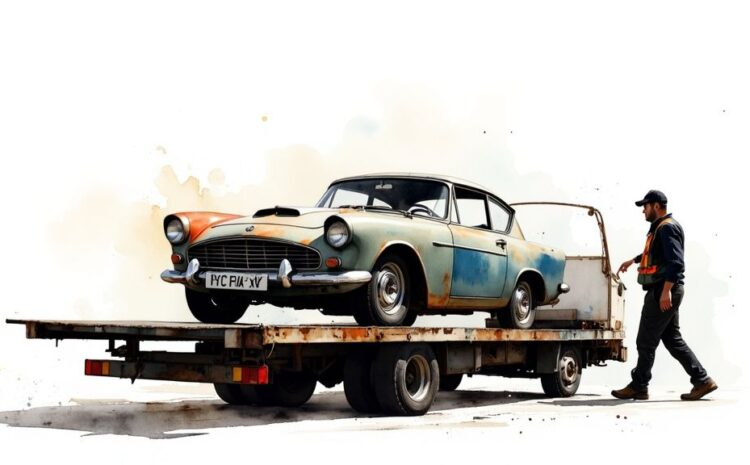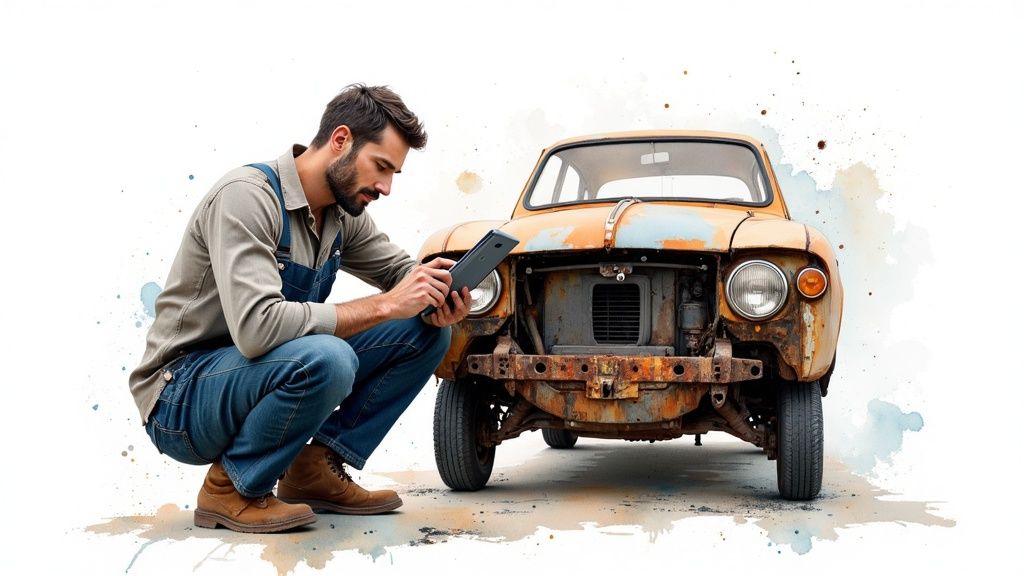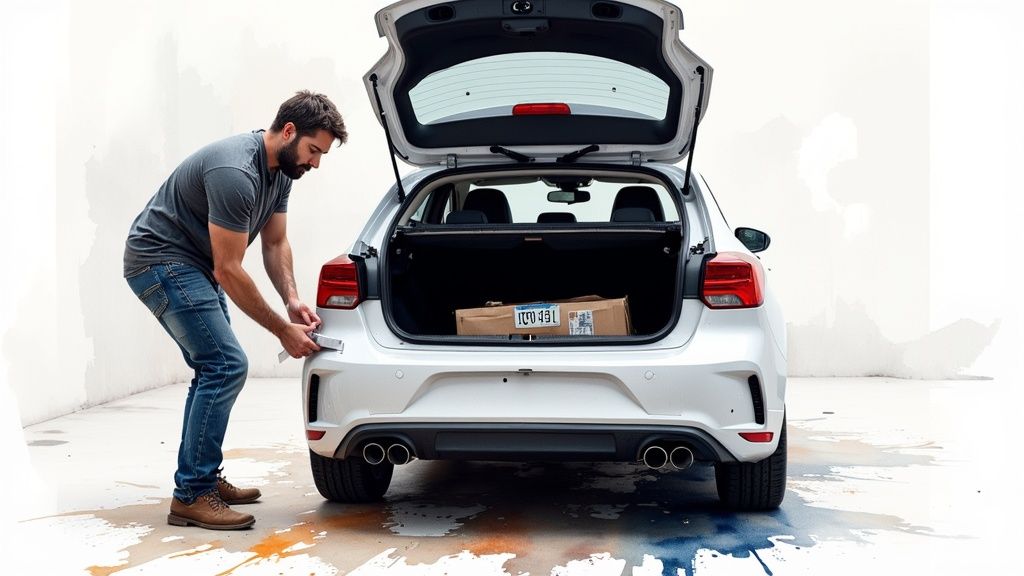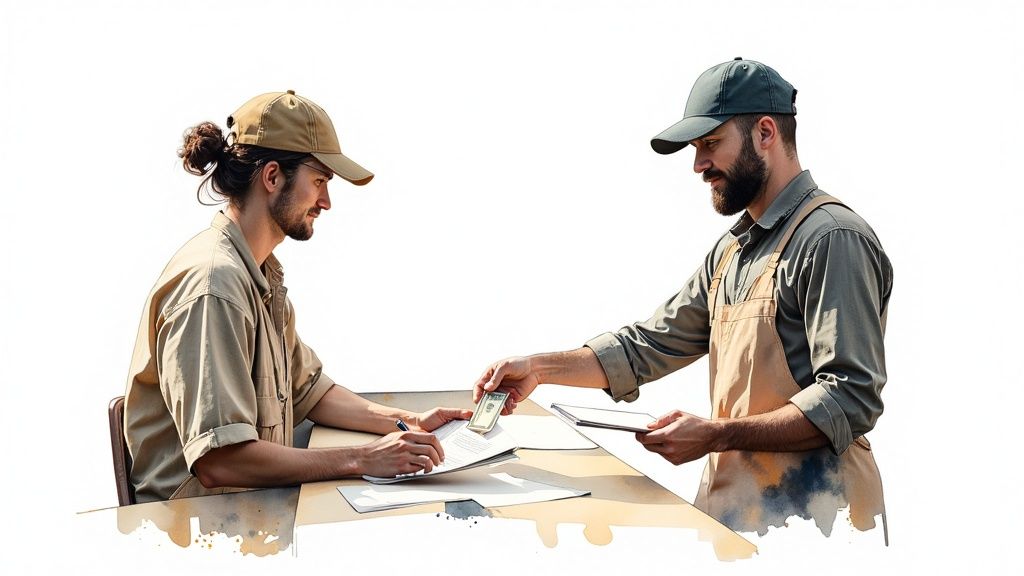
How to Scrap My Car in the UK A Complete Guide
Right, so you’ve got a quote and you’re ready to get rid of that old car. Before the collection truck turns up at your door, there are a few bits of housekeeping to take care of. Getting your documents and the vehicle itself sorted now will make the whole process completely painless and ensure there are no hiccups with your payment.
Getting Everything Ready for Collection Day

From my experience, a little bit of prep work goes a long way. Spending ten minutes getting your paperwork in order and clearing out the car can save you a world of hassle. Think of it as dotting the i's and crossing the t's – it’s what separates a smooth, quick collection from a frustrating, delayed one.
First, Sort Out Your Paperwork
The one document every scrap dealer will ask for is the V5C registration document, or what most of us just call the logbook. This is the official proof that you're the registered keeper. The driver who collects your car will need to complete section 4 (or section 9 on older V5Cs) with the scrap yard's details. Once that's done, you'll tear it off and send that slip to the DVLA yourself.
Now, don't have a meltdown if you can’t find your V5C. We’ve all been there, putting a document somewhere "safe" and it vanishing into thin air. You can still scrap your car, but you absolutely must prove you own it.
Legitimate scrap services will usually accept:
- A valid photo ID, like your driving licence or passport.
- A recent utility bill or bank statement showing your name and address, which needs to match the details the DVLA has on record for the vehicle.
The golden rule is to be upfront. If you don't have the V5C, tell the scrap company when you book the collection. They'll let you know exactly what they need instead. No reputable Authorised Treatment Facility (ATF) will touch a car without solid proof of ownership – it’s a legal requirement.
Next, Prep the Car Itself
With the documents sorted, it's time to turn your attention to the vehicle. The most important job? Clearing out all your personal stuff. I can't tell you the number of times people call back asking about things they’ve left inside. Go through it with a fine-tooth comb: check the glove box, the boot, under the seats, and in all the little storage cubbies. Once that car is on the tow truck, it's gone for good, and so are your favourite sunglasses or that forgotten stack of CDs.
You also need to think about whether you want to keep any parts. Maybe you’ve got a set of mint-condition alloy wheels you could sell, or a decent sound system you want for your next car.
A Word of Warning: If you plan on removing anything, you must agree this with the scrap company beforehand. The price you were quoted is based on the car being complete. If you suddenly whip out the catalytic converter or the gearbox, the value will plummet because scrap prices are heavily based on weight. A quick chat avoids any nasty surprises.
Finally, do the collection driver a favour and make sure the car is easy to get to. If it’s wedged in a tight spot on your drive or stuck in a garage with a dead battery, clear a path. It just makes their job quicker and easier, which means you get paid and can get on with your day.
Before collection day arrives, a quick check of your to-do list is always a good idea. Here’s a simple table to help you keep track of everything you need to do.
Your Car Scrapping Checklist
| Item | What to Do | Why It's Important |
|---|---|---|
| V5C (Logbook) | Find it and have it ready. If it's lost, get your photo ID and a proof of address. | This is the primary proof of ownership required by law. Without it, you need alternative ID. |
| Personal Items | Thoroughly check the glove box, boot, and all compartments. Remove everything. | Once the car is collected, you won't be able to retrieve any forgotten belongings. |
| Removable Parts | Decide if you're keeping parts like alloy wheels or the stereo. | You must agree on any removals with the scrap company beforehand to avoid a price reduction. |
| Vehicle Access | Ensure the car is in a spot where a recovery truck can easily access and load it. | Prevents delays on collection day and makes the handover smooth for everyone. |
Running through this simple checklist guarantees you're fully prepared. It turns what could be a stressful process into a straightforward task, ensuring you meet all legal requirements and get your money without a hitch.
Finding the Right Place to Scrap Your Car
So, you’ve decided to send your old car off to the great scrapyard in the sky. Now comes the most important part: choosing who does the scrapping. This isn’t just about getting the best price; it's about making sure everything is done legally and responsibly.
In the UK, the only place that can legally scrap a car is an Authorised Treatment Facility (ATF). Think of them as the officially licensed recycling centres for vehicles.
An ATF has been approved by the Environment Agency, which means they have the proper equipment and training to safely remove all the hazardous materials—like oil, fuel, and battery acid—before the car is crushed and recycled. Going with an unlicensed operator is a huge mistake. Not only is it illegal, but you could still be legally responsible if your car ends up dumped on a roadside somewhere.
Don't Just Take Their Word for It—Check Their Credentials
You absolutely must verify that you're dealing with a legitimate ATF. Some dodgy outfits will try to tempt you with a cash-in-hand offer, but they often "forget" to provide the official paperwork. That leaves you wide open to fines and legal headaches down the line.
Thankfully, checking is easy. The Environment Agency keeps a public database of every single licensed facility.
You can pop their company name or postcode into the search tool. It's a simple, quick check that gives you complete peace of mind.
If the company you’re considering shows up with a valid permit for handling end-of-life vehicles (ELVs), you’re good to go. If they’re not on that list, walk away. It's that simple.
Should You Go Local or Use a National Service?
When you start looking for quotes, you’ll find you have two main options: ringing up a local ATF yourself or using a national comparison website.
- Going with a local ATF: Sometimes, dealing directly with a local scrapyard feels a bit more personal. You can often chat with the actual person who will come and collect your car, which some people prefer.
- Using a national service: Comparison sites do the legwork for you by getting quotes from a whole network of pre-vetted ATFs. This saves you a ton of time and can even get you a better price as different yards compete for your car.
Neither way is necessarily better than the other; it really boils down to what you prefer. Do you want the convenience of a one-stop-shop, or do you like the idea of supporting a local business? Our guide on how to scrap your car digs into the pros and cons to help you decide.
The Bottom Line: Whether you choose a yard down the road or a national online service, the most critical step is confirming they are a licensed ATF. Always check the Environment Agency register before you agree to anything.
What’s My Scrap Car Actually Worth?
The quote you get for your car isn't just a number plucked from thin air. It’s calculated based on a few solid factors that every ATF uses to value a vehicle.
By far, the biggest factor is the car's weight. Scrap metal is a commodity, bought and sold by the tonne. A heavy Land Rover has a lot more metal in it than a Ford Ka, so it will almost always be worth more, even if it’s in worse condition.
A few other things come into play, too:
- Make and model: Some cars are known for having valuable parts that can be salvaged and resold.
- Missing components: Is the engine still in it? How about the gearbox and catalytic converter? A complete car is worth significantly more than a stripped-out shell.
- The global price of metal: The market value for steel, aluminium, and other metals changes daily. This can cause the quotes you receive to go up or down slightly from one week to the next.
Knowing this helps you see why the offers vary and gives you a much better idea of what a fair price looks like.
Finalising the Scrappage and Arranging Collection
Right, you’ve got a quote you’re happy with and you’ve done the basic prep. What happens next is actually pretty simple. The scrap company will get in touch to arrange a collection time that works for you. One of the best parts about dealing with a proper Authorised Treatment Facility (ATF) is that the collection itself is almost always completely free.
When the recovery driver turns up, they'll give your car a quick once-over. This isn't a detailed inspection; they're just making sure the car is as you described it. For example, they need to see that it's a whole car, not a shell with all the valuable parts already stripped out. These drivers are pros and will have your car, even if it's a non-runner, loaded up safely in no time. Honestly, the whole thing is usually done and dusted in less than 15 minutes.
Sorting the All-Important Paperwork
This is the one part of the handover you really need to pay attention to. Before the car goes anywhere, you and the driver need to sort out the V5C logbook. A common mistake is to just hand the whole book over, but you shouldn't do that.
You only need to complete a specific section of the V5C with the collection agent. On most modern logbooks, this is Section 4, which is for 'Selling or transferring your vehicle to a motor trader, insurer or dismantler'. If you have an older V5C, it might be Section 9.
Make sure you fill this part out together, getting these details from the driver:
- The full name and address of the ATF (the scrap yard, not the driver's home address).
- The date the vehicle is being transferred.
- The ATF’s VAT number, if applicable.
You’ll both sign the declaration in this section. The driver then takes the main body of the V5C, and you must keep the yellow slip (V5C/3). This slip is your proof of the transfer until the official confirmation comes through. Don't let them leave with the entire logbook.
Here’s a quick rundown of the essential documents you'll need on the day.

Having these things ready makes the whole process smooth and ensures everything is handled legally and by the book.
Getting Your Proof of Scrappage
Once your old car is on its way, the ATF takes it back to their facility for processing. After it has been properly depolluted and the shell has been crushed, they have a legal duty to issue a Certificate of Destruction (CoD).
The Certificate of Destruction is your golden ticket. It's the official, legal document proving your car is off the road for good and has been recycled correctly. Crucially, it's what formally ends your responsibility for the vehicle.
The ATF will generate this CoD directly from the DVLA's online system. You should expect to receive a copy, usually by email, within about seven working days. If a week or so passes and you've heard nothing, give the scrap company a call to chase it up. This certificate is vital, so make sure you receive it.
With the CoD in hand and the DVLA notified via your V5C slip, you're all done. You can relax knowing the job's been done properly and responsibly.
Finalising Your Paperwork with the DVLA

Your car has been collected and the all-important Certificate of Destruction is on its way. Brilliant. But there’s one last crucial piece of admin to sort out.
Until you tell the DVLA you're no longer the owner, you are still legally responsible for the vehicle. Skipping this step isn't an option—it can lead to automatic fines and a lot of headaches you just don't need.
The easiest way by far is to use the DVLA's online service. It’s designed to be quick and you can get it done in a few minutes with a cup of tea. Once you've filled it out, you get an instant email confirmation. It’s your proof that you’ve done your bit, with an official letter to follow in the post.
Using the DVLA Online Service
To get this sorted online, you'll need the 11-digit reference number from your V5C logbook. This is the number on the yellow slip (V5C/3) that you should have kept when the collection driver took the main part of the document.
You just pop this number into the online form, along with the scrap dealer's details and the date they took the car. Simple as that.
This is genuinely the best way to cover yourself. As soon as you hit 'submit', there's a digital record that you’ve transferred the vehicle. It officially severs your ties to the car, meaning you won’t have to worry about any rogue parking tickets or other fines turning up on your doorstep.
If you prefer to do things the old-fashioned way, you can still use the post. You’ll need to fill out Section 4 (or Section 9 if you have an older V5C) and send it off to the DVLA in Swansea. This method works perfectly well, but it’s slower and leaves you waiting for confirmation.
When dealing with any kind of official forms, it's easy to make a simple mistake that can cause delays. To sidestep any potential issues, it’s worth being aware of common legal document mistakes and how to avoid them.
Claiming Your Road Tax Refund
Now for the good bit. Once you've notified the DVLA, they will automatically issue a refund for any full months of road tax (Vehicle Excise Duty) you have left. There's no separate form to fill out or number to call—it all happens automatically.
The DVLA calculates the refund from the date they get your notification. They’ll then post a cheque to the address they have for you on the V5C, so it’s a good idea to make sure your details are correct beforehand.
Here’s what to expect with your refund:
- It’s automatic: You don't need to do anything extra once you've told the DVLA.
- You'll get a cheque: The payment will arrive by post.
- It takes a few weeks: The cheque usually lands on your doormat within six weeks.
If six weeks go by and you've still not seen anything, it's probably time to give the DVLA a quick call to find out what's happening.
By ticking off these final steps, you can rest easy knowing you've handled the entire car scrapping process correctly, with no loose ends to worry about.
Exploring UK Car Scrappage Schemes

Sometimes, scrapping a car is about more than just getting rid of a vehicle that’s seen better days. It can actually be a savvy financial move. Beyond what you’d get from a standard scrap dealer, special scrappage schemes run by the government or car manufacturers can offer you a pretty hefty incentive to trade in your old, polluting car for a much cleaner, newer one.
These schemes are all about cleaning up our air, especially in urban areas. They work by encouraging drivers to ditch high-emission vehicles. In return, you might get a grant, a discount on a new car or van, or even credit for public transport. They aren’t running all the time or everywhere, but you'll often find them active in cities with Clean Air Zones (CAZs) or an Ultra Low Emission Zone (ULEZ).
How These Schemes Work
So, what’s the catch? Well, these schemes—whether run by a local council or a car brand like Ford or Hyundai—have very specific rules. Not every car or owner is going to qualify, which is the main thing to remember. The whole point is to get the worst polluters off the road, so they typically target vehicles based on age, their emissions standard (think pre-Euro 4 petrol or pre-Euro 6 diesel), and even how long you’ve been the registered owner.
London’s ULEZ scrappage scheme is probably the best-known example of this in action. The push to get older vehicles scrapped has been massive, with the ULEZ scheme's funding jumping from £110 million to a huge £210 million by February 2024. This resulted in over 54,000 applications getting the green light, with nearly £189 million committed to helping Londoners move to cleaner transport.
To apply, you’ll usually need to prove you own the car, live in the right area, and provide all the vehicle's details. It does mean a bit of paperwork, but the financial reward can make it more than worthwhile.
Expert Tip: Keep an eye on your local council's website and the official sites of major car manufacturers. These offers are usually time-sensitive and can offer thousands of pounds towards your next set of wheels.
Are You Eligible for a Scrappage Grant?
Eligibility is the big question. It’s the first thing you need to check, and the rules vary from one scheme to another. However, there are a few common requirements you'll almost always see:
- Vehicle Type and Age: The focus is nearly always on older cars and vans that don't meet modern emission standards.
- Ownership Duration: You’ll likely need to prove you've been the registered keeper for a set period, often 12 months or more. This stops people from snapping up old bangers just to cash in on the scheme.
- Residency: Council-run schemes are typically restricted to people living within that specific clean air zone.
If you tick all the boxes, the process is usually pretty clear, but you have to follow their instructions to the letter. Taking a moment to understand how a scrappage scheme works in more detail will put you in a great position to get your application approved and make the most of the offer. Getting that grant can turn a simple car disposal into a major helping hand towards a modern, efficient new vehicle.
Common Car Scrappage Questions Answered
When you’re at the finish line of scrapping your car, it’s completely normal for a few last-minute questions to pop up. I see it all the time. People want to be sure they’re ticking all the right boxes, especially when it comes to the official paperwork and getting paid. Let's run through some of the most common queries I hear.
What If I Can't Find My V5C Logbook?
This is probably the number one worry. You’ve turned the house upside down, and the V5C is nowhere to be found. Don’t panic. While having the logbook makes things a bit smoother, a reputable Authorised Treatment Facility (ATF) won't turn you away.
You can still scrap the car. They'll just need you to prove you are who you say you are. A valid photo ID, like your driving licence, paired with a recent proof of address (a utility bill from the last three months usually does the trick) will work instead. The key is to just be upfront about it when you book your collection.
Payment and Paperwork Problems
"Can I get cash?" is another question that comes up a lot. The answer is a simple, straightforward no. Thanks to the Scrap Metal Dealers Act 2013, it's actually illegal for any scrap dealer to pay you in cash for a car. This law was brought in to clamp down on metal theft, so every transaction has to be traceable.
You'll always be paid by a secure bank transfer or a business cheque. It protects you and the ATF.
So, what about the paperwork you get back? Your Certificate of Destruction (CoD) is the golden ticket that proves the DVLA knows your car is off the road for good. You should get this emailed to you within seven working days of the car being collected. If it hasn't landed in your inbox by then, get on the phone with the ATF. It's your official proof, so don't be afraid to chase it up.
To get a better idea of how your car's final price is worked out, you can learn more about how much you could get to scrap your car.
Can I scrap a car that isn't registered in my name?
In short, no. You have to be the legally registered keeper to scrap a vehicle. It’s a measure to prevent theft and fraud, so an ATF won't—and can't—accept a car from someone who can't prove they are the rightful owner with the correct documents.
And what about outstanding finance? This is a non-starter. A car with an active hire purchase or loan agreement can't legally be scrapped because, technically, you don't own it yet—the finance company does. You'll need to settle the balance in full and have the lender remove their interest in the vehicle before an ATF can touch it.
Once your old car is gone, you might start thinking about its replacement. If so, getting to grips with understanding auto loan options is a great next step.
Ready to scrap your car the easy way? Fast Scrap Car offers competitive prices, free same-day collection across London and Surrey, and instant payment. Get your free, no-obligation quote today at https://fastscrapcar.co.uk.
